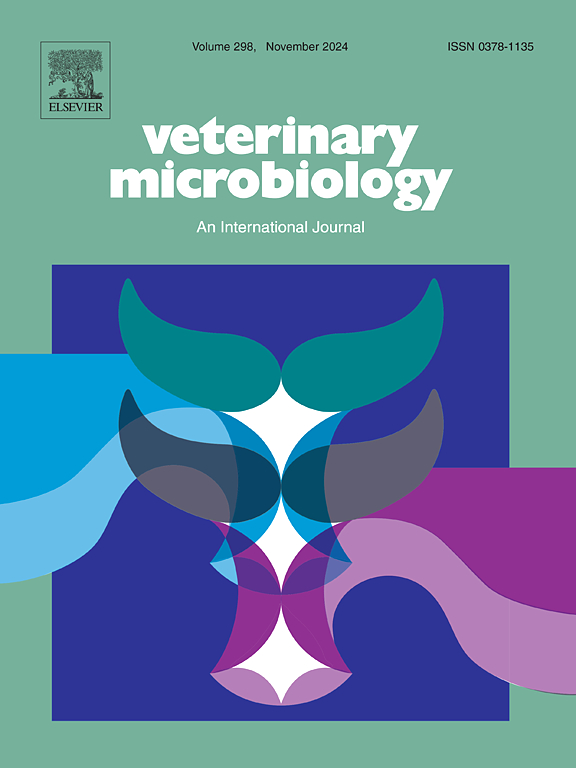Host helicase DHX36 inhibits pseudorabies virus proliferation by unwinding the G-quadruplex in the 3’UTR of IE180
IF 2.4
2区 农林科学
Q3 MICROBIOLOGY
引用次数: 0
Abstract
The balance between proliferation and persistence of pseudorabies virus (PRV) in the host is crucial for its long-term survival. Understanding the mechanisms that regulate viral survival may offer new strategies for disease prevention and control. The immediate-early gene 180 (IE180) is essential for PRV replication, and we previously identified a G-quadruplex (PQS18–1) located in the 3’ untranslated region (3’UTR) of IE180 that enhances its expression and promotes viral replication. However, the mechanisms by which this G-quadruplex is unwound and contributes to immune evasion remain unclear. In this study, we identified the host helicase DHX36 as a binding partner of PQS18–1 through RNA pull-down assays. Both in vitro and cellular experiments demonstrated that DHX36 destabilizes the G-quadruplex, thereby suppressing gene expression and regulating PRV replication. Our findings reveal a novel host-virus interaction mechanism involving G-quadruplex structures and helicase activity, which may offer new targets for therapeutic intervention.
宿主解旋酶DHX36通过解绕IE180 3'UTR中的g -四重体抑制伪狂犬病毒的增殖
伪狂犬病毒(PRV)在宿主体内的增殖和持续性之间的平衡对其长期存活至关重要。了解调节病毒存活的机制可能为疾病预防和控制提供新的策略。即时早期基因180 (IE180)对PRV复制至关重要,我们之前发现了位于IE180 3 ‘非翻译区(3 ’ utr)的g -四重体(PQS18-1),该基因可以增强其表达并促进病毒复制。然而,g -四重体解绕并导致免疫逃避的机制尚不清楚。在本研究中,我们通过RNA下拉实验确定了宿主解旋酶DHX36是PQS18-1的结合伙伴。体外和细胞实验均表明,DHX36破坏g -四重体的稳定性,从而抑制基因表达并调节PRV复制。我们的发现揭示了一种涉及g -四重体结构和解旋酶活性的新型宿主-病毒相互作用机制,这可能为治疗干预提供新的靶点。
本文章由计算机程序翻译,如有差异,请以英文原文为准。
求助全文
约1分钟内获得全文
求助全文
来源期刊

Veterinary microbiology
农林科学-兽医学
CiteScore
5.90
自引率
6.10%
发文量
221
审稿时长
52 days
期刊介绍:
Veterinary Microbiology is concerned with microbial (bacterial, fungal, viral) diseases of domesticated vertebrate animals (livestock, companion animals, fur-bearing animals, game, poultry, fish) that supply food, other useful products or companionship. In addition, Microbial diseases of wild animals living in captivity, or as members of the feral fauna will also be considered if the infections are of interest because of their interrelation with humans (zoonoses) and/or domestic animals. Studies of antimicrobial resistance are also included, provided that the results represent a substantial advance in knowledge. Authors are strongly encouraged to read - prior to submission - the Editorials (''Scope or cope'' and ''Scope or cope II'') published previously in the journal. The Editors reserve the right to suggest submission to another journal for those papers which they feel would be more appropriate for consideration by that journal.
Original research papers of high quality and novelty on aspects of control, host response, molecular biology, pathogenesis, prevention, and treatment of microbial diseases of animals are published. Papers dealing primarily with immunology, epidemiology, molecular biology and antiviral or microbial agents will only be considered if they demonstrate a clear impact on a disease. Papers focusing solely on diagnostic techniques (such as another PCR protocol or ELISA) will not be published - focus should be on a microorganism and not on a particular technique. Papers only reporting microbial sequences, transcriptomics data, or proteomics data will not be considered unless the results represent a substantial advance in knowledge.
Drug trial papers will be considered if they have general application or significance. Papers on the identification of microorganisms will also be considered, but detailed taxonomic studies do not fall within the scope of the journal. Case reports will not be published, unless they have general application or contain novel aspects. Papers of geographically limited interest, which repeat what had been established elsewhere will not be considered. The readership of the journal is global.
 求助内容:
求助内容: 应助结果提醒方式:
应助结果提醒方式:


